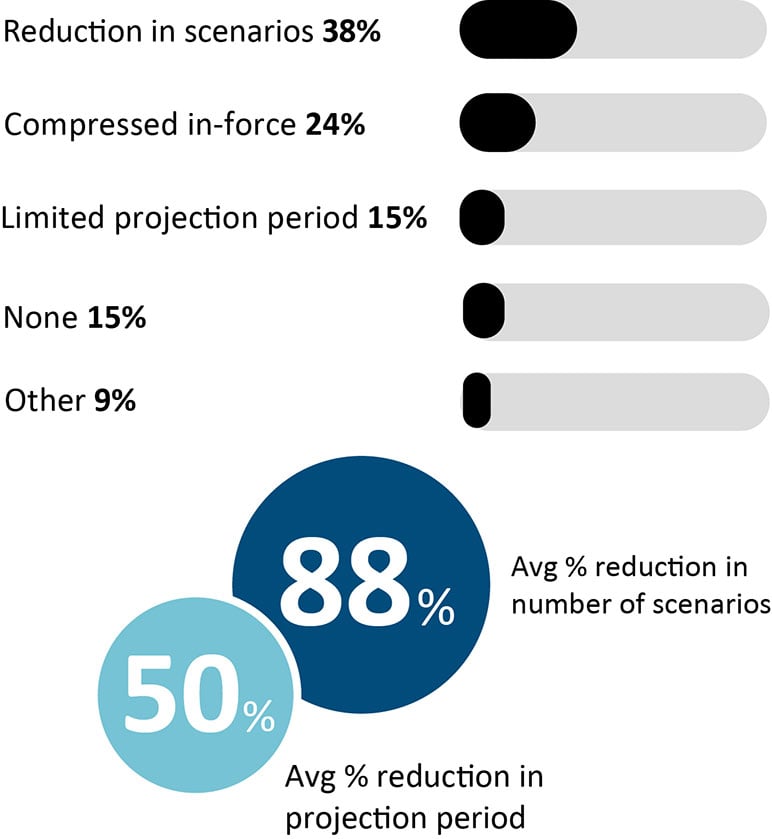A Look Into Current Life Insurance Modeling Programs and Processes

Modernization is a popular buzz word among actuaries these days that is used to describe rethinking and redesigning actuarial processes—including data, modeling, and analysis. Some goals of modernization programs are to increase efficiency of current processes, comply with and support the increased analysis needed for new regulatory requirements, and satisfy internal key stakeholder initiatives. With PBR business continuing to grow and LDTI and/or IFRS17 implementations in flight, current models and reporting processes will grow in complexity. Without some form of intervention, such as modernization efforts, reporting timelines and analysis capabilities may be impacted due to increased runtime and processing speeds or model limitations.
Many companies are curious how their own holistic reporting programs and modernization efforts stack up compared to peers. Oliver Wyman recently completed a survey focused on actuarial hot topics and trends related to life insurance products with a specific focus on modeling and analysis programs. With over 40 companies participating, the survey results provide a broad industry perspective on modeling software preferences, runtime reduction techniques, and front-end and back-end process approaches. This article summarizes key insights with respect to participant modeling programs and processes.
Actuarial Software … Liabilities and Assets
MG-ALFA® and Moody’s AXISTM are the most commonly used actuarial software packages for life insurance product liability modeling, which is consistent with results from previous surveys Oliver Wyman has conducted. Participants reported the “open source code” capabilities of MG-ALFA® as a key feature while the ability to have a “flexible one-model solution” is a highlight for Moody’s AXIS.TM Still, some participants indicated an interest in a software conversion, primarily in preparation for regulatory requirements, as part of larger consolidation efforts, and/or for increased flexibility.
Detailed modeling of assets is an area that may still be new for many actuaries, including software vendors. The majority of participants reported using multiple software packages to model assets (e.g., both AXIS and BondEdge). The need for a second software for asset modeling may indicate that there are shortfalls with the leading liability modeling software packages, for example, in modeling of certain structured assets. Consolidated asset-liability models provide a streamlined data feed, reduce the strain on resources, and may mitigate the risk of user error—this could be an area where cost benefit analysis may be warranted within ongoing modernization efforts.
Runtimes are Expected to Increase
Model runtimes are a growing concern for most life insurers with the expectation that model runtimes will continue to increase as regulatory requirements are implemented as shown in Figure 1.
Figure 1
Expected Runtime Changes for Regulatory Requirements
Ninety percent of participants have considered expanding or purchasing grid or cloud computing capabilities to address runtime concerns. While many have found success with cloud computing in terms of runtime, cloud programs come at a cost and companies are still interested in simplifying calculations where possible and without loss of material integrity.
The most common modeling technique to reduce runtime is to minimize the number of scenarios used in projections; on average participants are reducing their scenario set size by 88 percent. One method used to test scenario reduction fidelity is to run the model with the full scenario set one time and then again with a reduced scenario set to determine the impact to key financial metrics. Companies typically perform periodic testing to confirm the tradeoff is still appropriate, and additional testing when economic environments move dramatically, or major assumption or methodology changes are implemented. It is worth noting that the tolerance of variance in metrics may be subject to a lower threshold for reported items that are reviewed by auditors or regulators as compared to thresholds used for internal analysis.
Other common methods used to reduce runtime are shown below in Figure 2.
Figure 2
Runtime Reduction Techniques
Pre- and Post-model Processes are Also an Area of Focus
Most participants reported a desire to make process improvements, outside of their core actuarial liability and asset models, to their pre- and post-model processes. Over half of participants are spending more time running processes and preparing results than reviewing and analyzing—indicating a need to improve both front-end data processes and back-end analysis tools. On the front-end, where the focus is mainly on organizing input data (e.g., historical financial data, in-force files, assumptions, etc.) participants indicate that their biggest challenge is the number of administrative systems and the amount of manual effort required to extract, transform, and load data. On the back end, where the focus is on reporting and reviewing results, participants are starting to utilize visualization packages that allow for the results to be easily interpreted, trends to be analyzed, and drill down capability enhanced.
Looking Forward
Modeling and process improvements are continually a to-do item. With concurrent regulatory and accounting changes, there is an opportunity to include many of these improvements in broader modernization efforts. Companies that are able to identify and communicate current and expected pain points will need to exit these modernization efforts equipped with the processes needed to meet reporting and stakeholder requirements. The insights presented in this article may be helpful when shaping or re-shaping process improvement and modernization programs.
Statements of fact and opinions expressed herein are those of the individual authors and are not necessarily those of the Society of Actuaries, the newsletter editors, or the respective authors’ employers.


